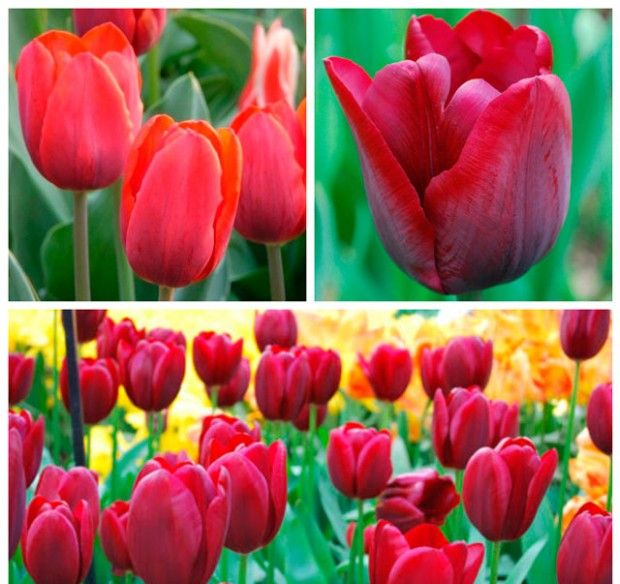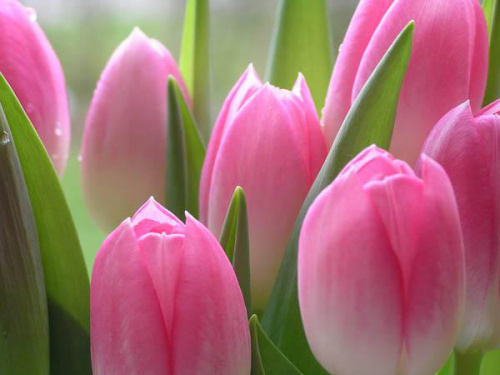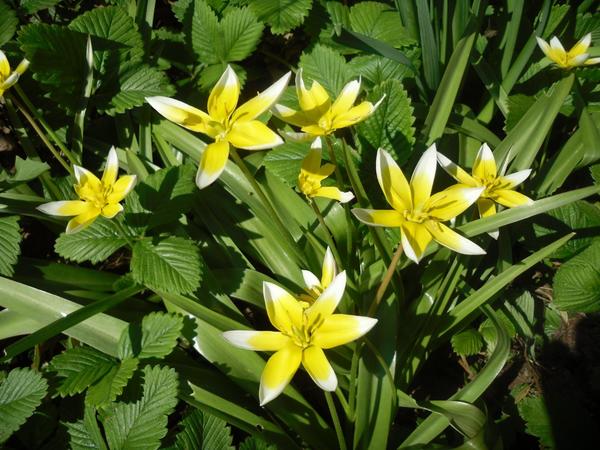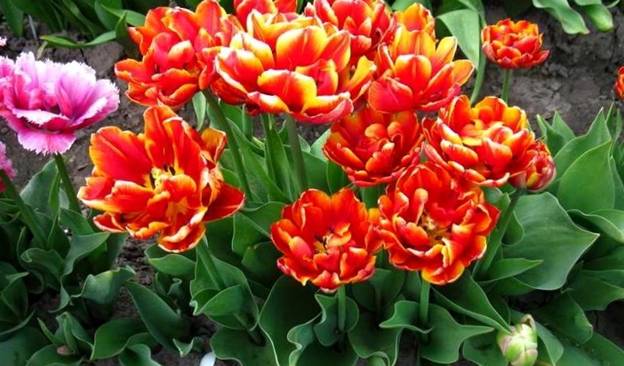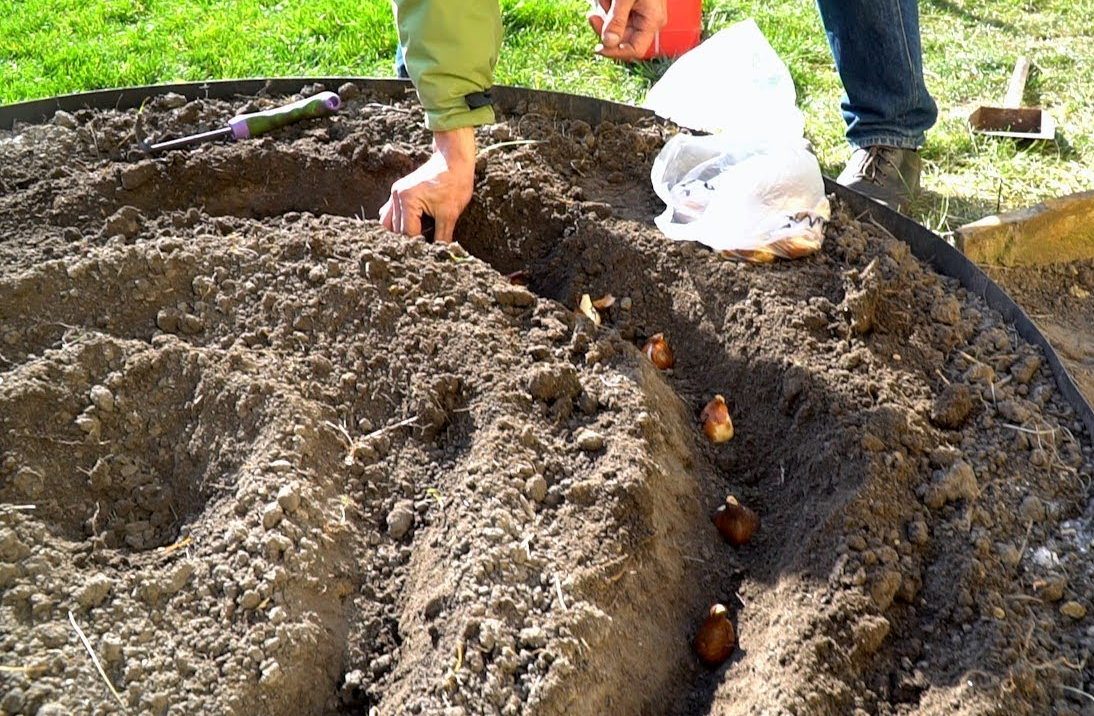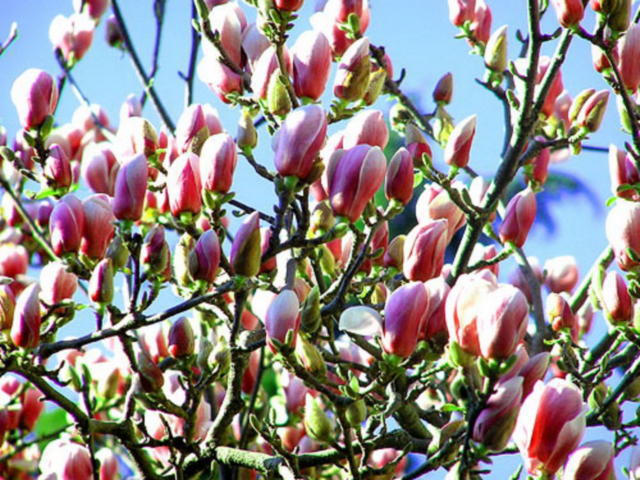Content:
Tulip is a perennial bulbous plant belonging to the lily family and originating from the countries of Central Asia. It is very easy to determine the meaning of its name. In fact, this is a distorted word "turban". It was this headdress, according to the first admirers, that the tulip flowers looked like.
Briefly about tulips
A tulip can reach a height of 10-100 cm. Its root system is represented by adventitious roots emanating from the bulbous bottom and dying off every year at the end of the flowering period.
Erect stems are cylindrical in shape. On them, elongated-lanceolate leaves are alternately located, painted in a bluish-green color (the unusual color is due to the presence of a thin waxy coating). The top leaf is the smallest, and the bottom is the largest.
Usually a tulip has only one flower (although there are many-flowered varieties). Its shape is correct, but depending on the chosen culture, it can be:
- lily-shaped;
- oval;
- goblet;
- cupped;
- pion-shaped;
- fringed;
- stellated, etc.
The diameter of the flower, depending on the variety, can be from 3 to 10 cm. In full disclosure - up to 20 cm. The length of the petals reaches 12 cm. The perianth is formed by six leaves; there are also 6 stamens with elongated anthers. About what flowers garden tulips are, should be discussed separately for each variety.
Characteristics of the most beautiful tulip species
Since November 1981, Dutch growers have used a special classification, according to which 10,000 tulip varieties (most of which were bred in the Netherlands) are divided into 4 groups and 15 classes.
The first class of this group includes simple early varieties, characterized by a small height (25-40 cm). Their goblet or cupped flowers are red or yellow in color.
The second class is also represented by early species of tulips of similar colors, but we are already talking about varieties with double flowers reaching 10 cm in diameter when fully opened. Flowering in these plants, reaching 25-35 cm in height, is very long.
Mid-flowering
The third class includes the Triumph varieties, 40-70 cm high. It can be both snow-white and purple tulips with large goblet flowers. There are also more exotic options. For example, you can get blue tulips. In fact, they are pale purple, but through the efforts of breeders they acquire the necessary shade. But blue tulips are still just a pipe dream.
Class number 4 - Darwin's hybrids, growing up to 60-80 cm. The diameter of the flower (usually rich red) is 10 cm. These Dutch tulips are frost-resistant and immune to the variegated virus.
Late blooming
The fifth class of the third group includes simple late varieties of tulips. During the day, they are thick and tall (up to 60-75 cm). The flowers are goblet and have a square base. The petals are blunt-pointed. The colors are very diverse: white, pink, burgundy, lilac, etc.There are even two-color varieties.
The sixth class is represented by lily-colored varieties. The petals of multicolored tulips in this category are slightly bent and pointed. In addition, these plants are known for their graceful goblet-shaped flowers.
Grade 7 combines varieties with different origins and one common feature: a needle-like fringe that frames the edges of the petals. Due to this feature, they are collectively called fringed tulips. The color and shape of their flowers can be very different.
In the eighth class, tulips were identified, called green-colored. Their distinctive feature: the green backs of the petals, which remain so throughout the season.
Rembrandt tulips with large and variegated goblet flowers occupied the smallest ninth grade. The basic tone of their petals, covered with strokes and spots, is red, white or yellow.
However, the status of the most exotic plants was assigned to representatives of the tenth class: parrot tulips. The edges of their petals are covered with many deep "cuts", due to which they are shaped like a bird's wing. The overall impression is complemented by a bright color, ranging from white to black and red.
Late terry varieties got into the eleventh grade. They are distinguished from the earlier ones by the larger size of the flower and the ripening time of the buds.
Species and botanical
The first representative of the group: low (15-25 cm) and early Kaufman varieties (class No. 12). Their large elongated flowers, when opened, acquire a star-shaped shape. Their color can be different, but most often it is two-tone (with purple stripes and specks).
In the 13th grade, you can find varieties of yellow, pink, bright red and orange Foster tulips. They have large goblet flowers up to 15 cm long.
Class No. 14: Greig's varieties. The height is small, the flower is large, has a wide base. The red petals are slightly bent back.
The 15th grade was assigned to botanical tulips. They are characterized by early flowering and short stature. These are typical features of all wild tulip species. Their colors can be very diverse. In addition, multiflorous tulips can be found among these plants. However, admiring their beauty is often short-lived. For example, the steppe species of these plants fade after a week.
The wild-growing Bieberstein tulips can also be attributed to the last class. Their flowers are relatively modest in size, but have a certain charm, and therefore are often used in bouquets.
Out-of-class
Bush tulips did not get their own class. They are notable for the presence of a large number of flower-topped stems growing from a single bulb.
No less interesting are the tall varieties of the “Russian Giants” series, bred only recently. Flowers belonging to this line have a very delicate color and pleasant outlines.
Features of planting and caring for tulip species
It is preferable to plant the bulbs in late September or early October. In case of urgent need, you can wait for April. It will take 3-4 weeks for tulip bulbs to root.
Tulips prefer bright sunlight, but they also take root in areas with light partial shade. The soil in the location chosen for planting should be:
- slightly alkaline or neutral;
- well drained;
- fertile;
- loose;
- sandy loam;
- fertilized with compost and ash.
Water it regularly and abundantly. 10-40 liters of water should go per square meter of the plot occupied by the most beautiful tulips. Compliance with this rule is especially important during the period when buds are laid or flowering occurs.
Tulips are fed three times per season:
- when shoots appear (at the same time, all non-germinated bulbs must be removed from the ground);
- during budding;
- after flowering.
However, fresh manure should not be used as fertilizer. Because of this, the likelihood of bulb decay and the development of fungal diseases in the plant increases significantly.
The optimal time to dig out tulip bulbs: after 2/3 of the leaves turn yellow. After that, the bulbs are laid out in one layer in an open box and stored under such conditions until September at a temperature of 20 ° C in a well-ventilated room (it is strictly forbidden to place them in direct sunlight). If planting is postponed to spring, then the storage temperature is lowered to 17 ° C.
If the winter is cold and with little snow, then the planted bulbs must be mulched with straw, sawdust, peat or humus.
Reproduction
Tulips reproduce by seeds and vegetatively (by means of daughter bulbs). In the second case, the formation of hollow stolons is observed in young bulbs, which are lateral shoots directed downward or to the sides. At their bottom, daughter bulbs are formed, which can be used for reproduction.
Seeds are obtained from a tulip fruit - a triangular box. Outwardly, they will resemble flat yellow-brown triangles. But seed propagation is usually only used by breeders, since the resulting flowers do not retain the varietal characteristics of their parents.
To get bulbs from the collected seeds, they are sown and grown in the same place for two to three years. After that, new bulbs are dug up, stored and re-planted as usual. True, seed tulips reach the peak of decorativeness only 8-12 years after sowing.
However, when cutting beautiful tulips, at least 2-3 leaves must be left, which will ensure normal nutrition and development of the bulb.
Treatment of diseases
Tulips are susceptible to a number of diseases and viruses.
Rot (wet, soft, root, gray and white)
The cause of the development of rot is excessive dampness and its appearance can be prevented only by fulfilling all agrotechnical requirements for growing tulips.
Tobacco necrosis (August disease)
The most obvious symptoms of this fungal disease are ugly streaky flowers and curved stems. In addition, dark spots may appear on the bulbs. In order to prevent mass infection, all affected plants are immediately removed, and the holes remaining after them are treated with a hot solution of boric acid and manganese (3 g and 10 g, respectively, per 1 liter of water). The rest of the tulips are sprayed with a 2% solution of foundationol for preventive purposes.
Variegated virus
The last of these ailments manifests itself as uncharacteristic spots, strokes on the leaves and petals of the plant. It is the most dangerous of all of these, because it does not respond to treatment.
All plants infected with variegated leaves should be dug up together with part of the adjacent soil and burned. The hole remaining after this must be filled with a strong solution of potassium permanganate.
Growing a tulip tree
Tulip liriodendron is an extremely unusual ornamental plant that can withstand frosts down to -30 ° C. This tall deciduous tree, called a tulip tree and resembling an oak in appearance, can reach a height of 30-50 m. It grows 1 m in height and 20 cm in width per year. Its life span can be up to 500 years.And the plant acquired its unusual name due to the characteristic tulip-shaped flowers of yellow-green color.
In order to successfully grow a tulip tree at home, planting and care must be carried out in accordance with all agrotechnical requirements. First of all, this concerns the elimination of drafts and maintaining an optimal humidity level (at 65%). You will also need a nutritious soil. In addition, the plant will need to be fed twice a year.
The easiest way to care for a tulip tree is if it grows in sandy-clayey, sufficiently moist, but well-drained soil (moisture stagnation will certainly lead to the development of diseases). It is best to plant it in spring: in warm soil and in a sunny area. It is recommended to use cuttings for plant propagation, but you can also use seeds.
Moscow region tulips
To grow your tulips near Moscow, no special tweaks are required. Almost all of the above varieties, subject to the established agrotechnical requirements, will successfully grow throughout central Russia. The florist is only required to choose exactly the variety that will really delight him with its external characteristics.
There are a really large number of tulip varieties, the most beautiful ones have been noted in this article. Now it is much easier to decide which varieties to plant on your site to create a beautiful landscape design.

